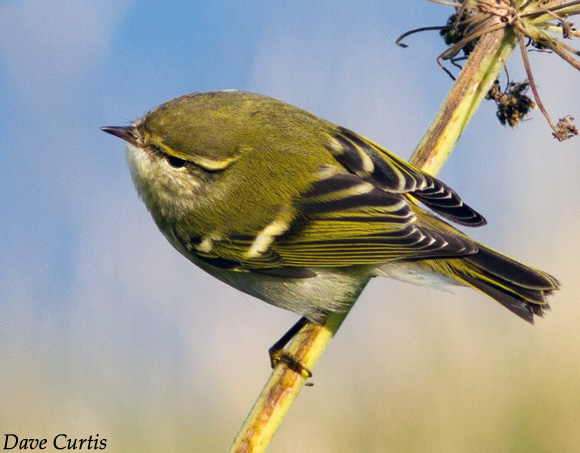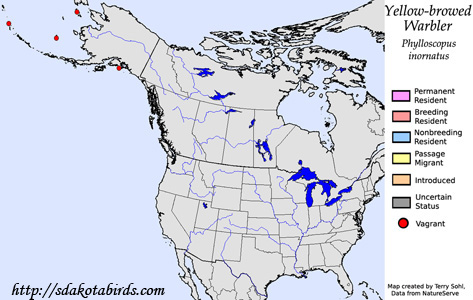| Length: 4 inches | Wingspan: 7 inches | Seasonality: Non-resident in South Dakota |
| ID Keys: Long cream-colored eyebrow, greenish upperparts, pale underparts, two pale wingbars, | ||
 The
Yellow-browed Warbler (also kinown as the Inornate Warbler) is a very small
songbird of Eurasia. Their normal range during the summer months is
primarily in Sibera, while they overwinter in southern and southeastern
Asia. While most birds are found in eastern Asia in both summer and winter,
it is a species that is prone to wander, with small numbers appearing as far
as western Europe every Autumn. In North America they are vagrants,
with several sightings on the islands and coastlines of Alaska.
The
Yellow-browed Warbler (also kinown as the Inornate Warbler) is a very small
songbird of Eurasia. Their normal range during the summer months is
primarily in Sibera, while they overwinter in southern and southeastern
Asia. While most birds are found in eastern Asia in both summer and winter,
it is a species that is prone to wander, with small numbers appearing as far
as western Europe every Autumn. In North America they are vagrants,
with several sightings on the islands and coastlines of Alaska.
Habitat: Found in a variety of broad-leaf forest and woodland habitats.
Diet: Feeds on insects and spiders
Behavior: A very active forager, moving sporadically through vegetation as it searches for insects. They may feed in the forest canopy, but will also feed in thickets and shrubs or on the ground.
Nesting: The nest of a Yellow-browed Warbler is a dome made of grasses, moss, and other plant material, with the opening on the side. The nest is placed on the ground, typically placed against the base of a clump of grass or other vegetation, or amidst protective roots. The female lays 4-6 eggs, and she alone incubates them. The eggs hatch after 12 or 13 days, with both parents feeding the young.
Song: The call is a surprisingly sharp and loud for such a tiny bird, and is comprised of two syllables. The song is a thin, high-pitched series of whistles.
Migration: Strongly migratory, breeding in Siberia and overwintering in southeastern Asia.
Interactive eBird map: Click here to access an interactive eBird map of Yellow-browed Warbler sightings
Similar Species: In the Old World they are possibly confused with other small songbirds, but vagrants in North America are relatively distinct. Their tiny size and active movements may make them difficult to distinguish from other small active birds in North America, such as Ruby-crowned Kinglet.
Conservation Status: Yellow-browed Warblers are found across a broad geographic area, are common in parts of their range, and overall populations appear to be stable. The IUCN lists the Yellow-browed Warbler as a species of "Least Concern".
Further Information: 1) Birdlife International - Yellow-browed Warbler (Inornate Warbler)
2) WhatBird - Yellow-browed Warbler
3) Royal Society for the Protection of Birds - Yellow-browed Warbler
Photo Information: Photo by Dave Curtis - September 19th, 2013 - Stonybreck, Scotland, United Kingdom - Photo licensed under Creative Commons Attribution NonCommercial NoDerivs 2.0 Generic License
| Click below for a higher-resolution map |
 |
| South Dakota Status: Non-resident in South Dakota |
Additional Yellow-browed Warbler Photos (coming soon!!)
